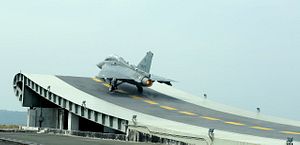Two naval prototypes of the Hindustan Aeronautics Limited (HAL) Light Combat Aircraft Tejas successfully conducted 33 test flights from a so-called Shore Based Test Facility—a full-scale model of an aircraft carrier deck—in Goa last month, according to the Business Standard.
The flight trials occurred between March 27 and April 25 and involved the aircraft, armed with two R-73 air-to-air missiles, taking off with the aid of a ski-jump from a 200-meter runway. “In December 2014, the Naval Tejas had taken off from the SBTF ski-jump after rolling 300 meters,” the Business Standard reports.
The Tejas LCA is expected to be deployed aboard the INS Vikrant, India’s first indigenously built aircraft carrier, as well on the country’s first 65,000-ton supercarrier, the INS Vishal, the second ship of the Vikrant-class.
The INS Vikrant will also carry MIG 29K fighter aircraft, and there has been some speculation whether the Indian Navy will opt for a different medium fighter jet for the INS Vishal (See: “India to Consider French Fighter Jets for Navy’s Newest Aircraft Carrier”).
The Tejas LCA is a supersonic, single-seat, single-engine multi-role light fighter aircraft and has been co-developed by the Aeronautical Development Agency (ADA) in cooperation with HAL to replace the Indian Air Force’s aging fleet of MiG-21 and MiG-23 aircraft.
The LCA program has encountered multiple delays in the past three decades. However, the head of ADA, CD Balaji, was optimistic about the recent flight trials and outlined next steps:
With this campaign, ski-jump launches are no longer a challenge. We will now explore the limits the fighter can be taken to. We will further fine-tune the control law software to take-off with higher payloads.
Next to practising regular take-off and landing as well as jettison fuel in the event of an in-flight emergency, the aircraft and pilots have also repeatedly practiced “hot refueling”—refueling the fighter jet with the engines running and the pilot in the cockpit. In addition, ADA and HAL have also been vigorously testing on-board computer programs used for landing the aircraft on the carrier.
“In the current campaign, the Tejas did over 60 approaches (without actually touching down) to gather data for fine-tuning the control law software. In the next campaign this month, we will do ‘touch and go’ approaches to validate the software and then graduate to full landings,” Balaji explained.
Testing aboard the INS Vishal will likely begin next year. “By mid-2017, we will have established on the SBTF that the Naval Tejas can be flown off an actual carrier, and we will then graduate to ship-based testing. We currently have two prototypes in testing, and will build a third by then,” said the ADA chief.
































